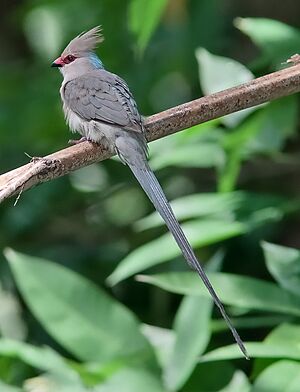Mousebird facts for kids
Quick facts for kids Mousebirds |
|
|---|---|
 |
|
| Blue-naped mousebird (Urocolius macrourus) | |
| Scientific classification |
|
| Kingdom: | Animalia |
| Phylum: | Chordata |
| Class: | Aves |
| Clade: | Coraciimorphae |
| Order: | Coliiformes Murie, 1872 |
| Family: | Coliidae Swainson, 1837 |
| Genera | |
The mousebirds are unique birds that belong to the order Coliiformes. These fascinating birds are found only in Africa south of the Sahara Desert. They are the only group of birds that lives entirely on the African continent.
Long ago, during a time called the Paleocene (about 62.5 million years ago), mousebirds lived in many other places, including Europe and North America. This shows they have a very ancient history!
Contents
Discovering Mousebirds: Appearance and Unique Features
Mousebirds are slender birds, usually grey or brown. Their bodies are covered in soft, hair-like feathers. They are quite small, typically about 10 centimeters (4 inches) long. But don't let their body size fool you! They have a very long, thin tail that can be another 20 to 24 centimeters (8 to 9.5 inches) long. Most mousebirds weigh about 45 to 55 grams (1.6 to 1.9 ounces).
These birds have strong claws and special outer toes that can point forwards or backwards. This helps them grip branches really well. They also have a small crest of feathers on their heads and short, stubby bills.
Life in the Trees: Behavior and Diet
Mousebirds are very social creatures, much like their namesake, the mouse. They often live in groups of about 20 birds. You can find them in areas with light woods and bushes. They are known for scurrying through leaves and branches, almost like rodents. This is another reason they are called "mousebirds"!
They spend their days searching for tasty berries, fruits, and buds to eat. Mousebirds are very acrobatic. They can even hang upside down to reach food!
Building a Home and Raising Young
When it's time to build a nest, mousebirds create cup-shaped nests from twigs. They carefully line these nests with soft grasses. Female mousebirds typically lay two to three eggs in their nests.
Mousebirds Through Time: A Living Fossil
Scientists sometimes call mousebirds "living fossils." This is because the six species we see today are the last survivors of a much larger and more diverse group of birds that lived millions of years ago. Their ancestors were very common during the early Paleogene and Miocene periods.
We have found many fossils of ancient mousebirds. These fossils tell us a lot about their past. For example, some extinct relatives of mousebirds, called Sandcoleids, had strong talons like birds of prey. We've even found uncrushed seeds in the stomachs of some fossilized Sandcoleids! This gives us clues about what they ate.
Meet the Modern Mousebirds
Today, there are six species of mousebirds. They are divided into two main groups, or Genera: Colius and Urocolius. Each group has its own unique species, like the Blue-naped mousebird and the White-backed mousebird. These modern mousebirds continue the long history of their ancient family.
See also
 In Spanish: Cólidos para niños
In Spanish: Cólidos para niños

